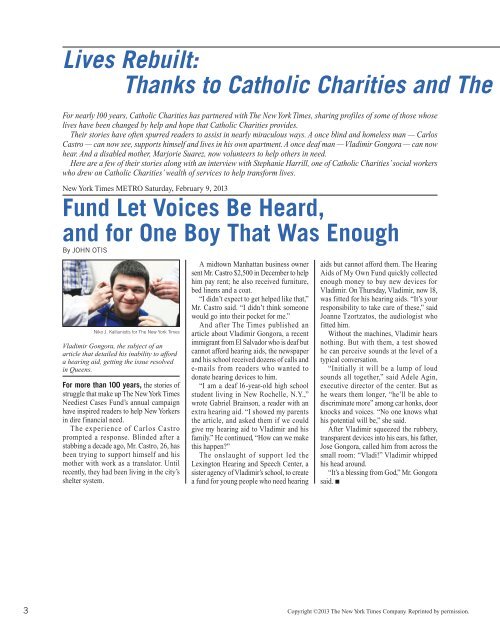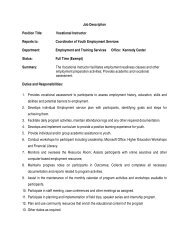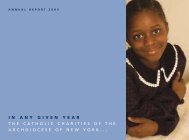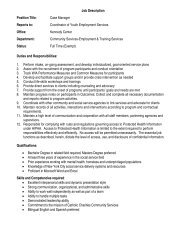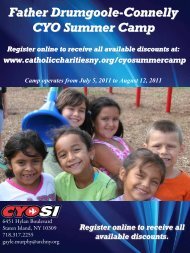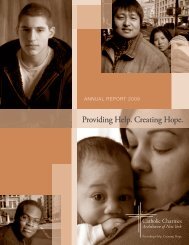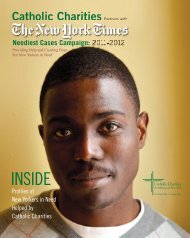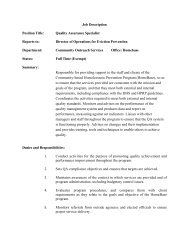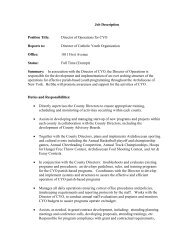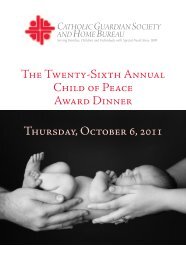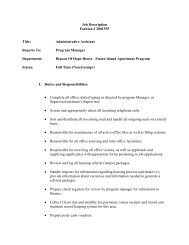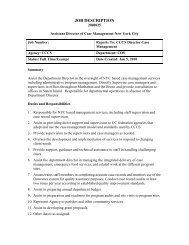Neediest Cases Campaign - Catholic Charities of the Archdiocese of ...
Neediest Cases Campaign - Catholic Charities of the Archdiocese of ...
Neediest Cases Campaign - Catholic Charities of the Archdiocese of ...
You also want an ePaper? Increase the reach of your titles
YUMPU automatically turns print PDFs into web optimized ePapers that Google loves.
Lives Rebuilt:<br />
Thanks to <strong>Catholic</strong> <strong>Charities</strong> and The<br />
For nearly 100 years, <strong>Catholic</strong> <strong>Charities</strong> has partnered with The New York Times, sharing pr<strong>of</strong>iles <strong>of</strong> some <strong>of</strong> those whose<br />
lives have been changed by help and hope that <strong>Catholic</strong> <strong>Charities</strong> provides.<br />
Their stories have <strong>of</strong>ten spurred readers to assist in nearly miraculous ways. A once blind and homeless man — Carlos<br />
Castro — can now see, supports himself and lives in his own apartment. A once deaf man — Vladimir Gongora — can now<br />
hear. And a disabled mo<strong>the</strong>r, Marjorie Suarez, now volunteers to help o<strong>the</strong>rs in need.<br />
Here are a few <strong>of</strong> <strong>the</strong>ir stories along with an interview with Stephanie Harrill, one <strong>of</strong> <strong>Catholic</strong> <strong>Charities</strong>’social workers<br />
who drew on <strong>Catholic</strong> <strong>Charities</strong>’ wealth <strong>of</strong> services to help transform lives.<br />
New York Times METRO Saturday, February 9, 2013<br />
Fund Let Voices Be Heard,<br />
and for One Boy That Was Enough<br />
By JOHN OTIS<br />
Niko J. Kallianiotis for The New York Times<br />
Vladimir Gongora, <strong>the</strong> subject <strong>of</strong> an<br />
article that detailed his inability to afford<br />
a hearing aid, getting <strong>the</strong> issue resolved<br />
in Queens.<br />
For more than 100 years, <strong>the</strong> stories <strong>of</strong><br />
struggle that make up The NewYork Times<br />
<strong>Neediest</strong> <strong>Cases</strong> Fund’s annual campaign<br />
have inspired readers to help New Yorkers<br />
in dire financial need.<br />
The experience <strong>of</strong> Carlos Castro<br />
prompted a response. Blinded after a<br />
stabbing a decade ago, Mr. Castro, 26, has<br />
been trying to support himself and his<br />
mo<strong>the</strong>r with work as a translator. Until<br />
recently, <strong>the</strong>y had been living in <strong>the</strong> city’s<br />
shelter system.<br />
A midtown Manhattan business owner<br />
sent Mr. Castro $2,500 in December to help<br />
him pay rent; he also received furniture,<br />
bed linens and a coat.<br />
“I didn’t expect to get helped like that,”<br />
Mr. Castro said. “I didn’t think someone<br />
would go into <strong>the</strong>ir pocket for me.”<br />
And after The Times published an<br />
article about Vladimir Gongora, a recent<br />
immigrant from El Salvador who is deaf but<br />
cannot afford hearing aids, <strong>the</strong> newspaper<br />
and his school received dozens <strong>of</strong> calls and<br />
e-mails from readers who wanted to<br />
donate hearing devices to him.<br />
“I am a deaf 16-year-old high school<br />
student living in New Rochelle, N.Y.,”<br />
wrote Gabriel Brainson, a reader with an<br />
extra hearing aid. “I showed my parents<br />
<strong>the</strong> article, and asked <strong>the</strong>m if we could<br />
give my hearing aid to Vladimir and his<br />
family.” He continued, “How can we make<br />
this happen?”<br />
The onslaught <strong>of</strong> support led <strong>the</strong><br />
Lexington Hearing and Speech Center, a<br />
sister agency <strong>of</strong> Vladimir’s school, to create<br />
a fund for young people who need hearing<br />
aids but cannot afford <strong>the</strong>m. The Hearing<br />
Aids <strong>of</strong> My Own Fund quickly collected<br />
enough money to buy new devices for<br />
Vladimir. On Thursday, Vladimir, now 18,<br />
was fitted for his hearing aids. “It’s your<br />
responsibility to take care <strong>of</strong> <strong>the</strong>se,” said<br />
Joanne Tzortzatos, <strong>the</strong> audiologist who<br />
fitted him.<br />
Without <strong>the</strong> machines, Vladimir hears<br />
nothing. But with <strong>the</strong>m, a test showed<br />
he can perceive sounds at <strong>the</strong> level <strong>of</strong> a<br />
typical conversation.<br />
“Initially it will be a lump <strong>of</strong> loud<br />
sounds all toge<strong>the</strong>r,” said Adele Agin,<br />
executive director <strong>of</strong> <strong>the</strong> center. But as<br />
he wears <strong>the</strong>m longer, “he’ll be able to<br />
discriminate more” among car honks, door<br />
knocks and voices. “No one knows what<br />
his potential will be,” she said.<br />
After Vladimir squeezed <strong>the</strong> rubbery,<br />
transparent devices into his ears, his fa<strong>the</strong>r,<br />
Jose Gongora, called him from across <strong>the</strong><br />
small room: “Vladi!” Vladimir whipped<br />
his head around.<br />
“It’s a blessing from God,” Mr. Gongora<br />
said. <br />
3 Copyright ©2013 The New York Times Company. Reprinted by permission.


